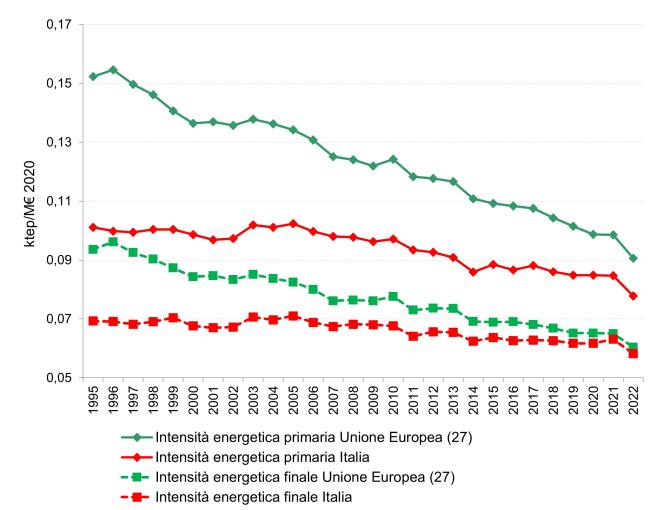Panel 1
Antonio Caputo, Giulia Iorio, Francesca Palomba
Comparison within the European Union highlights that Italy's primary and final energy intensity remains below the European average. This is largely due to historical lack of domestic primary energy sources, —which has fostered energy-saving behaviours, efficient infrastructure, and a relatively low energy-intensive production structure—as well as a high level of energy taxation (which has raised end-user energy prices above those in other countries), lower per capita income, and a relatively mild climate. Based on a ranking of countries by increasing primary energy intensity, Italy ranks 7th among European nations.
The indicator is a measure of an economy's energy efficiency and shows how much energy is needed in order to produce a unit of gross domestic product (GDP). Specifically, primary energy intensity is defined as the ratio of gross inland energy consumption to GDP, while final energy intensity is defined as the ratio of final energy consumption to GDP.
To assess the relationship between energy consumption trends and economic growth, with the aim of improving energy consumption efficiency.
With Decision No. 1386/2013/EU, the European Union established the 7th Environmental Action Programme, covering the period up to 2020. On 14 October 2020, the European Commission presented a proposal for a decision to establish the 8th Environmental Action Programme for the period 2021–2030, which was adopted by the Council of the EU on 29 March 2022. No specific targets are applicable to this indicator.
Panel 2
ENEA, Energy and Environment Report, various years.
Data quality assessment
EUROSTAT (Statistical Office of the European Communities)
EUROSTAT, https://ec.europa.eu/eurostat/data/database
MASE, National Energy Balance, various years. Available at: https://sisen.mase.gov.it/dgsaie/
Nazionale
1995-2022
Indicator assessment
The indicator consists of several parameters:
• The ratio between gross inland energy consumption and gross domestic product (GDP) at market prices in chained 2020 values for a given calendar year.
• The ratio between final energy consumption and GDP at market prices in chained 2020 values, while sectoral intensity is defined as the ratio between final consumption in toe (tonnes of oil equivalent) and value added in chained 2020 values.
In 2022, final energy intensity was 58.2 toe consumed per million euros, representing a 7.7% reduction compared to 2021. Energy intensity varies significantly across sectors (Table 1). The manufacturing industry and agriculture recorded the highest values, at 85.0 toe/M€ and 94.3 toe/M€, respectively. Among the sectors with the lowest energy intensity are the building sector (5.9 toe/M€) and services (13.4 toe/M€).
Despite significant year-to-year variability, final energy intensity exhibits a clear long-term decline, reflecting reduced energy consumption per unit of GDP. Overall, final energy intensity decreased by 16.1% between 1995 and 2022 (Table 1). Among the various sectors, construction and services showed rising energy intensity (+159.3% and +24.1%, respectively), indicating worsening resource efficiency; onversely, manufacturing achieved a 33.3% reduction in energy intensity, while transport (−16.1%) and agriculture/fishing (−7.5%) also recorded declines.
Data
Table 1: Sectoral and Total Final Energy Intensities (final consumption in toe/value added at chained 2020 prices)
Processing by ENEA based on data from MASE, Eurostat, and Istat
n.d. – data not available;
¹ Intensities not comparable with other sectors, as they are measured against GDP rather than their own "value added";
² Final energy consumption relative to GDP;
³ Primary energy consumption relative to GDP.
Table 2: Primary Energy Intensity¹ of GDP at Market Prices in Chained 2020 Values
Processing by ENEA based on EUROSTAT data
n.a. – data not available
¹ Defined as the ratio between gross inland energy consumption and GDP
-
Provisional data
° Break in time series
Table 3: Final Energy Intensity¹ of GDP at Market Prices in Chained 2020 Values
Processing by ENEA based on EUROSTAT data
n.a. – data not available
¹ Defined as the ratio between final energy consumption and GDP
-
Provisional data
° Break in time series
Figure 1: Primary Energy Intensity¹ (solid line) and Final Energy Intensity² (dashed line) of GDP at Market Prices in Chained 2020 Values in the EU and Italy
Processing by ENEA based on EUROSTAT data
¹ Defined as the ratio between gross inland energy consumption and GDP
² Defined as the ratio between final energy consumption and GDP

A comparison within the European Union shows that both Italy’s primary and final energy intensity remain below the EU average. This is largely due to the country’s historical lack of domestic primary energy resources—which has encouraged energy-saving behaviours, the development of efficient infrastructure, and a production structure that is not excessively energy-intensive—as well as high taxation (which has driven end-user energy prices significantly above those in other countries), lower per capita income, and a relatively mild climate.
The historical series on energy intensity indicates that EU values for primary and final energy intensity—91 and 60 toe/M€, respectively—are gradually converging with Italian levels. Based on a ranking in ascending order of primary energy intensity values, Italy ranks 7th among European countries (Tables 2 and 3, and Figure 1).